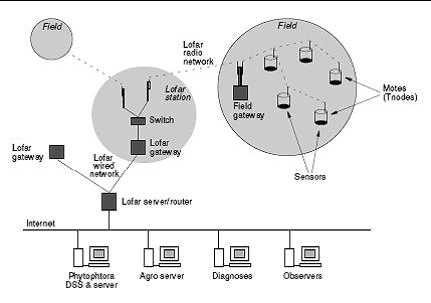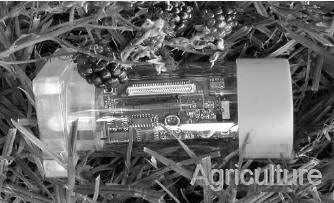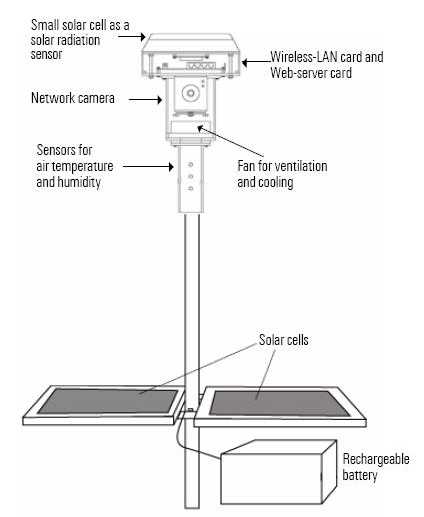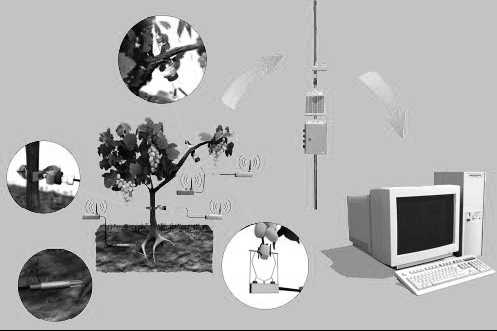Experimental Projects
This is a project done by the Lofar Agro project[14]. This is a good experimental
project to use sensor networks for agriculture. It has installed several sensor boards
(TNOdes) in a parcel for monitoring the crop(figure:6.2). The nodes are manually
localized so that a map of the parcel can be created. The TNOdes are equipped with
sensors for registering the temperature and relative humidity. To further improve
communication, the nodes are installed at a height of 75cm while the sensors are
installed at a height of 20, 40 or 60cm. In addition to the TNOdes, the field is
equipped with a weather station registering the luminosity, air pressure, precipitation,
wind strength and direction. The humidity of the soil is a major factor in the
development of the micro climate. A number of sensors that measure soil humidity
are also deployed in the field. Finally, an extra sensor measures the height of the
groundwater table.
A TNOde records the temperature and relative humidity every minute. For
energy-efficiency considerations, the nodes are reporting data only once per ten
minutes. To further save energy, the data sent over the wireless links is minimized
by using delta encoding. The TNOdes use TinyOS as operating system. Data is
thus sent using the multihop routing protocol MintRoute available within TinyOS
. The data collected by the TNOdes is gathered at the edge of the field by a field
gateway and further transferred via WiFi to a simple PC for data logging, gateway.
The gateway is connected via wire to the Internet and data is uploaded to a server
and further distributed to a couple of other servers under XML (figure:6.1).

Figure 6.1: Lofar Agro Setup

Figure 6.2: TNode
Water management
Water management [15] is important factor in agricultural field. Sensor networks
also can be use in water management in the field. Irrigation is a major issue in many
agricultural fields.
Maximizing the net benefits of irrigated crop production through an appropriately
designed agricultural water management program is needed. Growers are challenged
to practice protection practices, reduce runoff and other losses from irrigation. Also
they have to increase crop water use efficiency while meeting the crop water requirements
for maximum net return. It can be help farmers conserve water and energy
resources associated with irrigated crop production by using WSN.
An ideal proactive system would optimize water needs in different areas of the
field with available water particularly because water is a limited, shared resource.
Proactive computing means that design systems that interpret actionable data and
then automatically act on it. E.g.:
ˆ An irrigation system that optimally rations limited ground water
ˆ An automated call to the workers to come in and pick the crop when they’re
ripe
Being able to water plants more selectively and precisely on the basis of individual
plant needs and available water, would save water. This type of precision would be
time consuming for a farmer, so a proactive system that does it automatically.
Watermark sensors(figure:6.3) can be used for monitoring soil water status and
crop water use. The information that collected by watermark sensors can be utilized
for irrigation management.
Similarly, dealing with pests is another opportunity for proactive computing. For
example, It can be used to detect the presence of birds and alert the farmer about
the problem. It only takes a minute or two for a flock of birds to do serious damage

Figure 6.3: Moisture sensors
to a crop. A proactive approach would detect and respond to the bird presence,
perhaps by making big sound.
6.3 Full-Wireless FieldMonitoring Server for Sensor
network
Field Server (FS) is a strong server which can be installed in fields [17]. Field
Monitoring Server (FMS) is a kind of FS for monitoring combined with aWeb server,
sensors, a wireless-LAN and a special housing. FS can be a node of a sensor network
installed at fields (figure:6.4).Solar cell embedded on the top of FMSs have been used
as a light intensity sensors. The power source for FMS is supplied by a cable, since
the solar cell’s power alone is not sufficient to run conventional FMSs. Power supply
cable can be problematic to construct a massively distributed monitoring system by
using wireless sensor network in fields especially in paddy fields. It has developed
power saving technologies so that the solar cell can drive the FMS. Conventional
wired FMSs function as a backbone by using an ad-hoc network, where power is
usually supplied by cable or larger solar cell. Energy consumption of full-wireless
FMSs is half that of conventional FMSs. Sleep mode also is introduced for power
saving. That means FMS is switched off immediately after the Field server-agent
collects data.
For wireless sensor networks, data acquisition devices such as Mote or TINI ,have
been employed. However, casing and combination with sensors are important and,
in fact, difficult in the field. Generally conventional sensor network devices support
only a few sensors and slow speed communication. They are insufficient for
agricultural applications such as model base systems and do not meet the needs of
farmers. Some applications require much faster communication speed, and other
applications require data such as air temperature, humidity, PPFD (Photosynthesis
Photon Flux Density), UV, CO2 concentration, soil-moisture, EC, leaf-wetness, wind
speed/direction and GPS. FS must be water-proof, dust-proof and heat-resistant.
The full-wireless FMS can be installed easily, not only in upland fields also even
in paddy fields. However it has few problems. The first one was related to dew
condensation in the FMS when the inside temperature of the FMS was lower than
outside air temperature.

Figure 6.4: Wireless field monitor server

Figure 6.5: Parts of a field monitor server
This is an another implementation of sensor networks in a vineyard to react
against powdery mildew problem. Powdery mildew risk that can be calculated from
temperature data readings gathered throughout an agricultural field over a period of
time. A map generated in this way could easily demonstrate what areas of the field
were at the highest risk for powdery mildew. It would let the field farmers to spray
pesticides on the specific at risk area to avoid problems. Unanalyzed temperature
data would have been insufficient for this purpose. Because it calculates powderymildew
risk using one of a number of complex models that take temperature data
gathered over time as input. Temperature data could also be used to make heat
unit calculations, which is a factor in deciding when to harvest.
Another example of using wireless sensor networks in agriculture is reacting against
a fungal disease which can enter a agricultural field through a variety of sources.
The development and associated attack of the crop depends strongly on the climate
conditions within the field. Humidity is an important factor in the development
of the disease. Both temperature and whether or not the leaves are wet are also
important indicators. To monitor these three critical factors, it can be instrumented
the field with wireless sensors. The main goal of monitoring is to reveal when the
crop is at risk of developing the disease. Then let the farmer treat the field or parts
of it with fungicide only when absolutely needed.


